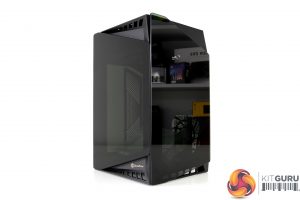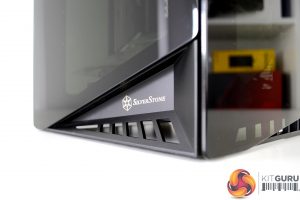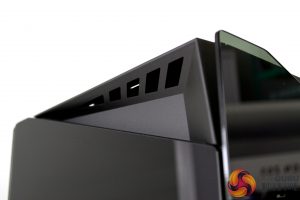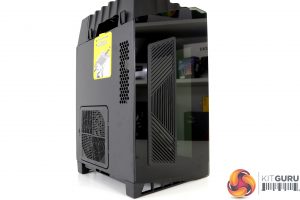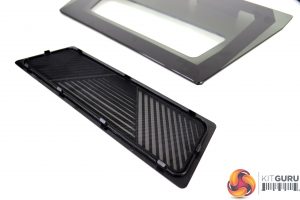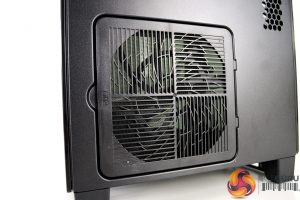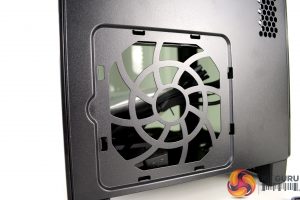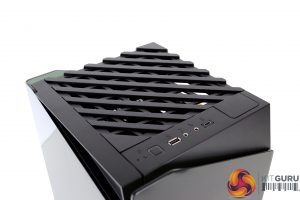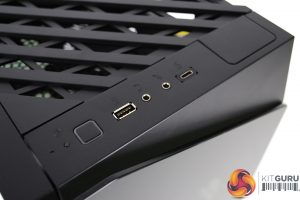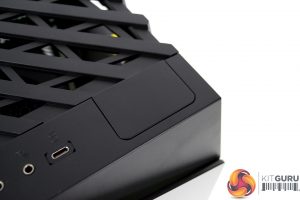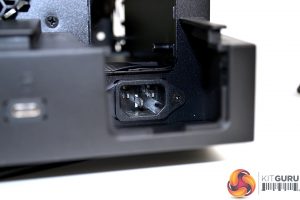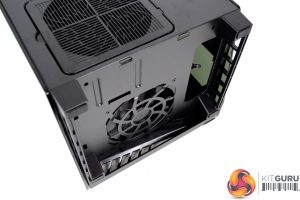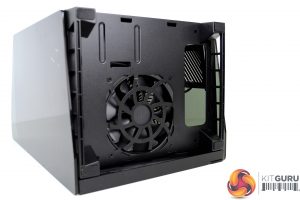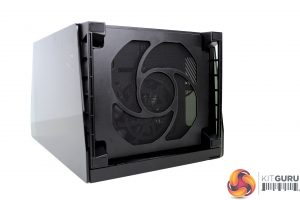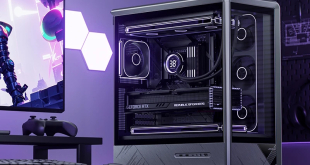The SilverStone LUCID LD03-AF arrived packaged in a brown cardboard box with an image of the case on the front, along with LD03 printed in a large bold text which is replicated on the rear. On the sides of the box are details about the case printed in different languages as well as a list of key features and specifications.
Three sides of the LD03-AF is covered with dark tinted tempered glass panels, which looks great and almost like some kind of display cabinet rather than a PC case. The only problem with all this tempered glass is taking photos without getting caught in the reflection isn’t easy. You may also find yourself cleaning the glass regularly to remove fingerprints.
The side of the case which is technically the front has a SilverStone logo printed in a light gold colour with angular vents at the top and bottom of the chassis to allow cool air to be pulled into the system via the internal 120mm fan.
With the case spun round 180⁰, we can see the tempered glass side panel that has the new GPU intake vent added. The vent is constructed from a plastic outer gill with an integrated woven plastic mesh dust filter. The vent can be removed from the glass panel for cleaning purposes.
Around the back of the case where you would normally find the rear I/O and power connection is rather sparse. There are just two vents on the back, one removable filtered vent for the power supply air intake and a smaller unfiltered vent underneath where the graphics card is positioned.
At the top of the case is a large exhaust vent to help expel warm air from the system via a 120mm pre-installed fan. Also, along the edge of the top panel is the front I/O, or top I/O in this case. The front I/O consists of just a single USB 3.0 Type-A port, one USB Type-C port, 3.5mm audio jacks for headphones and a microphone as well as a power button with power LED, reset button and HDD activity LED.
Alongside the front I/O ports is a small panel or cover, the cover can be removed to gain access to the power connection from the top. At a guess, I would say this is to make pushing the power cable into the socket easier, you could also leave the panel off to allow the power cable to exit from the top but this would probably look a little unsightly.
Situated at the base of the chassis are four feet with anti-vibration rubber pads that provide the case with approximately 30mm of ground clearance to assist cool air intake, as well as an intake vent covering the pre-installed 120mm intake fan.
There is also another cut-out in the bottom of the chassis to provide additional airflow to the graphics card, and the whole underside of the case is covered with a plastic mesh dust filter that is removable for cleaning and maintenance.
 KitGuru KitGuru.net – Tech News | Hardware News | Hardware Reviews | IOS | Mobile | Gaming | Graphics Cards
KitGuru KitGuru.net – Tech News | Hardware News | Hardware Reviews | IOS | Mobile | Gaming | Graphics Cards


